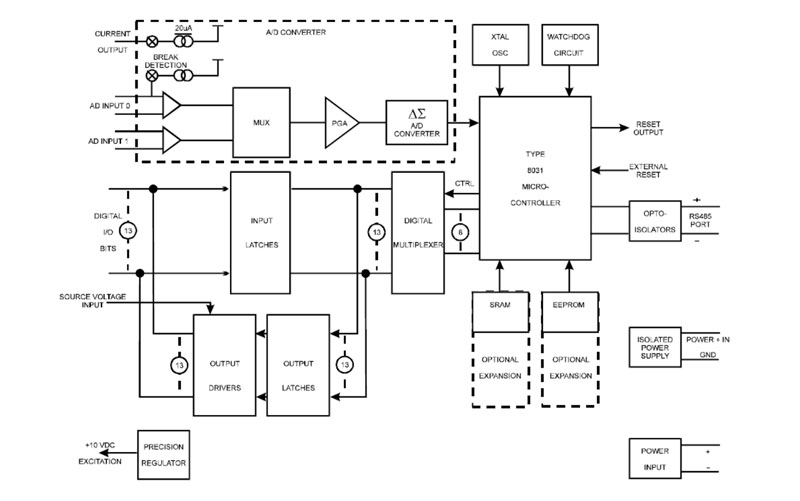

● Channels: 2 Differential.
● Data Coding: Binary for Unipolar inputs, Offset Binary for Bipolar inputs.
● Resolution: Dependent on filter frequency.
● Input Voltage Range: Software selectable, 0 – 2.5V and ±2.5V or, if jumper is used to select +5 VDC reference, 0-5V and ±5V.
● Input Impedance: 1 Gigohm at DC. Varies with input sample rate.
● Programmable Gains: 1, 2, 4, 8, 16, 32, 64, and 128.
● Overvoltage: Continuous single channel, to ±35V without damage.
● DC Input Leakage Current: @25°C, 10 pA max.
● Temp. Coefficient: Due to the thermal mass of the NEMA enclosure and internal heating by the power supply regulators, the pod reacts very slowly to any ambient temperature changes. Further, automatic re-calibration or background calibration can be used to remove temperature errors.
● Integral Nonlinearity: @ 25°C: ±0.0015% of Full Scale Reading max.TMIN to TMAX: ±0.0075% of FSR typical.
● Common Mode Rejection Ratio: 100 dB min., at DC.
● Normal Mode Rejection at 60 Hz: 100 dB ±0.02 x ? NOTCH min., for ?NOTCH, of 10, 30, 60 Hz.
● Common Mode Rejection at 60 Hz: 150 dB ±0.02 x ?NOTCH min., for ?NOTCH of 10,30, 60 Hz.
● Compensation Current: 20μA nom., constant current source for thermocouple cold junction reference measurements.
● Transducer Test Current: 4.5μA nom., switchable current source tied to the positive input lead of analog channel one to test the existence/ operation of any external sensor.
● Transducer Excitation: Precision 10 VDC (±0.01V) at up to 60 mA.
● Number: Thirteen, on same pins as the output bits, each bit is individually programmable as either an input or output bit.
● Sample Rate: Ports must be polled to read data.
● Logic Input Low: -0.5V to +0.8V.
● Logic Input High: +2.0V to +50.0V.
● Low-Level Input Current: -450 μA maximum.
● Number: Thirteen, on same pins as the input bits, each bit is individually programmable as either an input or output bit.
● Logic-Low Output Current: 350 mA maximum. Inductive suppression diode included in each circuit.
● High-Level Output Voltage: Open collector, compliance with up to 50V user supplied voltage. If no user supplied voltage, outputs pulled up to +5VDC via 10 KW resistors.
● Operating Temperature Range: 0° to 65°C (Optional -40° to +80°)
- (For Temperature De-rating considerations, refer to the “Temperature De-rating” discussion in the REMOTE ACCES Overview page that presents “Specifications common to all REMOTE ACCES pods.”)
● Storage Temperature Range: -50°C to +l20°C.
● Humidity: 5% to 95% RH non-condensing. Enclosure is designed to meet NEMA 4 requirements.
● Power for the opto-isolated section can be applied from the computer’s +12 VDC power supply via the serial communications cable or by an isolated local power supply. Power for the rest of the pod can be provided by a local power supply.
● Opto-lsolated Section: 7.5 to 23 VDC @ 40 mA maximum (7 mA at 12 VDC).
● Local Power: 10.5 to 16 VDC at 150 mA plus transducer excitation current used, if any. Also, note that the unit can be used with local power as low as 7.5 VDC but the 10 VDC excitation voltage and the +5 VDC reference voltage will not be available.